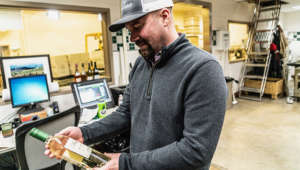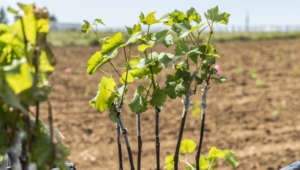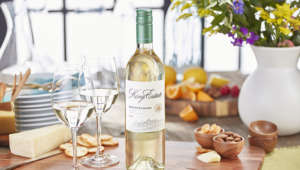King Estate is often credited with popularizing Pinot Gris, creating a market for the varietal where one had not previously existed. Today Pinot Gris is the second most popular white wine in America, after Chardonnay. Now we at King Estate are setting our sights on the varietal that currently ranks third among whites – Sauvignon Blanc. Most associated with New Zealand, Sauvignon Blanc accounts for just 5% of wine consumption in the U.S. But King Estate’s winemakers and CEO Ed King think the world is ready for an Oregon-style Sauvignon Blanc.
Since 2013 King Estate has made a Vineyard Designate Sauvignon Blanc from Croft Vineyard for our wine club members. But the 2018 King Estate Oregon Sauvignon Blanc is the first to carry the King Estate label and to be distributed nationally. And because it’s sourced from both the Willamette Valley and southern Oregon, it’s strikingly different from the Croft version. “Sauvignon Blanc doesn’t express terroir like Pinot Noir, but it still does,” Ray points out. “So a single vineyard expression (like Croft) isn’t going to have the same breadth and diversity” as a blend sourced from across the state.

The idea to dive into Sauvignon Blanc in a big way came out of a brainstorming session with the King family and the winemaking team. Director of Viticulture and Winery Operations Ray Nuclo, who previously worked with Croft before joining King Estate in 2013, had been advocating for Sauvignon Blanc since he arrived. He sensed the time was right. “I’ve always loved what the expression can be in Oregon,” he says.
COO and Winemaker Brent Stone agrees. “I’m a huge Sauvignon Blanc fan,” Brent says. “We’re excited to make it.” Part of the appeal is the opportunity to help define the Oregon style for Sauvignon Blanc “much like we did for Pinot Gris. There are so few Oregon Sauvignon Blancs. To get to be one of the first to do it for Oregon at the wholesale level was a real opportunity. It’s not very often in your career that you get to do something like this.”
Finding enough Sauvignon Blanc fruit in Oregon was the first challenge. Fortunately for King Estate, Ray had all the right connections to growers. Ray estimates that only about 2% of the grape production in Oregon is Sauvignon Blanc. For years it was thought that Oregon couldn’t grow good Sauvignon Blanc grapes because our climate was too cool, but the viticulture has developed enough to prove otherwise. In fact King Estate planted its first acre of Sauvignon Blanc last year and field-grafted over another half-acre onto Muscat vines. That fruit should be ready to harvest in 2020.

For the 2018 vintage, Ray was able to source from vineyard partners from the north Willamette Valley near Forest Grove to Jacksonville in the south. In all we bought 48.3 tons from eight vineyards in amounts as small as three-fourths of a ton to as much as 10 tons. To keep the fruit separate, King Estate purchased four new 70-gallon drums. As we embarked on this new winemaking adventure we wanted to know what we liked about the wine from each of more than two dozen different lots so we needed to keep them isolated from one another.
No state in the U.S. has carved out a reputation for Sauvignon Blanc. New Zealand and the Sancerre region in France are the wine’s best known producers but the styles are very different. New Zealand is fresh and fruity while Sancerre is known for being more mineral driven and rich.
Brent says he was surprised to discover how much winemaking could drive style, “how much a few degrees or different yeast strains really could affect the wine.” For example, to get the rich minerality of the Sancerre style, he would warm the fermentation up a few degrees and use a particular yeast to tamp down the aromatics before fermenting the wine in neutral oak, stainless steel and the concrete egg-shaped tank. For the New Zealand fruitiness, he’d do the opposite and ferment cool in stainless steel only, using a different strain of yeast to drive aromatic intensity.

These variables – yeast, fermentation and vessel – could each be adjusted, giving winemakers a broad range of options when it came time to blend. While they didn’t intentionally set out to find the middle ground between the two dominant regions, it turns out that’s just where the wine wanted to be – a balance of fruit and minerality that naturally emerged. “I really like the style we can get here,” Ray says. “It’s fruit forward, vibrant and interesting with character – a really versatile food wine.”
Winemakers are pleased with the results. Now it’s your turn. All of us at King Estate can’t wait to find out what you think of this very Oregon take on Sauvignon Blanc.
